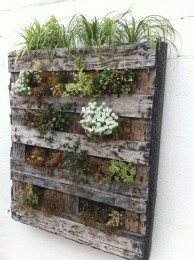1) Materials: The most important constraint for this project is whether I can procure the correct materials. Hopefully, I can find a derelict shipping pallet, but if not, I’ll have to build it all out of wooden planks. I am confident in my wood working skills, so the latter would not be a huge issue. Additionally, I want to put plywood at the back so I can hinge two pallets together. With the hinge, the pallets would be on an angle and the plywood would prevent the soil and plants from falling out.
2) Proper Growing Conditions: Will the pallet I find/build have enough space for plants to grow? Is the weather in Boulder between now and the end of the semester good enough for plants to grow? What type of plants can I grow based on space and weather conditions? All of these are unknowns and considerations for a successful project. I goal is to be able to eat whatever I grow to add to the dynamic aspect of the project. Also, I would like to grow more than just herbs: for example, some lettuce and maybe vegetables.
Boulder Area Spring Planting Guide: http://www.sturtzandcopeland.com/blog/st_patrick_s_day
Boulder Area Native Plant Suppliers: https://bouldercolorado.gov/osmp/nativegardens
3) Size/Weight: I would like to make sure that this garden can be stored in a storage closet when not in use. Therefore, it has to be relatively small, and light enough to be transported easily. The weight would not include the soil. When in use, I don’t think it would be movable because it would be too heavy.
4) Aesthetics: I am still struggling to determine which aesthetic I want to convey with my shipping pallet. At the moment, I am considering two very different directions: (1) colour/paint the wood and add small details with paint, (2) stain the wood for organic feel and either detail the wood with a burning tool or use black chalk board paint. Below are a few examples of different types of aesthetics for this project.



5) Cost: As there is no textbook for this class, I am expected to allocate the same amount of money towards projects. Ideally, I would like to spend less than 50$ on this entire project, but that is highly dependent on what materials I can find/reuse, and what I have to buy new. Below is a list of potential costs:
- Art Materials
- Wood
- Fasteners
- Soil
- Plants (seeds, bulbs, etc.)



3 Comments. Leave new
This is an interesting solution when you want to grow plants but don’t necessarily have the space to plant them. I think that this is spot on for the upcycle project.
This is an interesting project. I’ve always wanted to grow plants in a unique way as well. However, I think one of the requirements of the project is to have a moving part. I would make sure that the project will be good to go before starting.
Hey there Sofi, there used to be a discarded shipping pallet by the loading dock of the ITLL last week. I don’t know if it’s still there, but you should check!